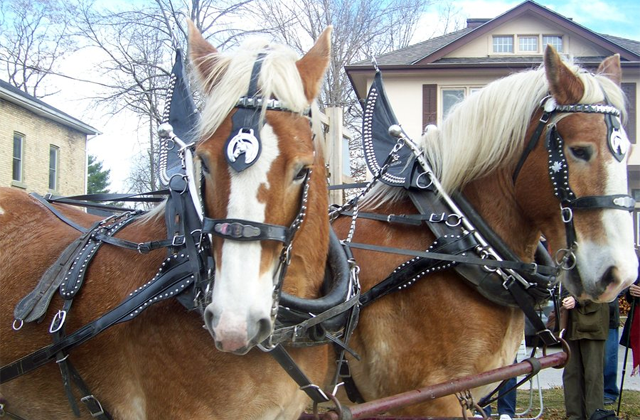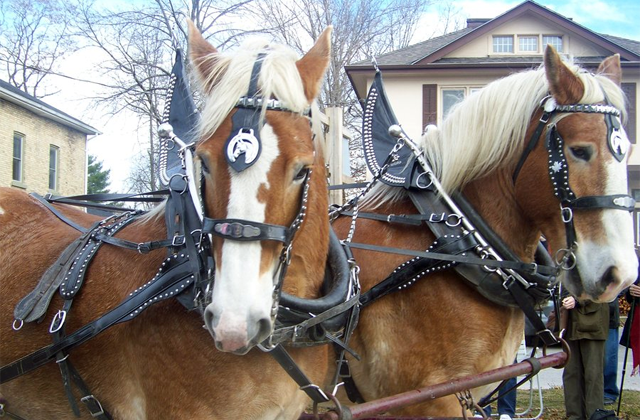
~GERALD RAFERTY
A Giant of Labor
The History of the Draft Horse
by MARILYN WITT
The draft horse is extremely powerful, with strong legs and a wide body. It has an impressive quality of strength and in times past was bred to pull a plow or a sledge. Though draft horses are still seen for pleasure riding and for competition today, it is important to remember how far back the history of these powerful horses go, and how long they have served capably and well in many different capacities. In their furthest history, it was thought that they came from the draft subtype of the ancient Forest Horse, but extremely early on, they were bred for the desirable traits of a strong frame and a gentle, docile temperament.
When the horse was domesticated, it was recognized that there were many different purposes that they could be put to. While riding horses needed to be quick and very responsive, heavier, more patient horses were thought to be more desirable for farm labor. They might be called into action in order to move heavy loads or to plow fields, and their steadiness was an asset when it came to work of this nature. Selective breeding over thousands of years resulted in the draft horses that we see today, ranging from the large Clydesdales to the popular Belgians.
When people think of draft horses in medieval Europe, their minds instinctively go to the destriers, horses that carried knights into battle. While it is true that destriers needed to be powerful enough to carry a knight in full armor, the truth was that there was little the medieval destrier had in common with a draft horse. Where a draft horse was bred to be docile and stable, a destrier needed to be both quick and extremely responsive both to its rider and to the battle going on around it. It has been theorized that the lighter draft horses, like the Friesian or the Andalusian, might be more similar to the destriers.
Just because they were not seen during the Crusades does not mean that the draft horse was not seen at all in warfare. As a matter of fact, patient and steady draft horses would go on to play an important part in the support work of World War I. To understand how many horses came in to Western Europe from the United States, consider the fact that in 1913, fewer than one thousand horses were shipped in from America. During the next five years, at the height of World War I, more than 1 million horses were shipped in. With the innovation of trench warfare, lighter Calvary style horses could not effectively maneuver over the field. It was the draft horses that were more useful; they were the ones who could pull artillery with nearly tireless strength, carrying both ammunition and supplies. Of the one million plus horses that went to Europe for World War I, only 200 horses returned home.
The horses that we recognize as draft horses today, with their powerful bodies and impressive height may have first appeared on the scene in the beginning of the nineteenth century. These horses were bred for transporting freight and for farming, and they were of a particular use when it came to pulling carriages and carts, especially in the time before the railroads. In America, the early twentieth century saw thousands of draft horses being shipped in from Europe. During the last part of the nineteenth century, there were many American draft registries founded, and by 1915, the Percheron was the most numerous draft horse to be found in America.
After a decline following the invention of the automobile and the truck, the modern draft horse is seeing a marked increase in numbers. More and more people are realizing that the heavy draft horse breeds have some very important contributions to make, whether it is for trail riding or in the show rings. Today’s draft horses are still in use in an entertainment capacity all over the world, but this is far from their only function.
Whether you are interested in seeing draft horses in action or you are interested in owning one, take some time and really consider learning more about the history of this breed.
—-
CREDITS
Article
Witt, M. (2009, July 20). The History of the Draft Horse.
Retrieved September 3, 2012, from http://ezinearticles.com/?The-History-of-the-Draft-Horse&id=2637908
Image
by PEACHESROX; http://peachesrox.deviantart.com/art/Belgian-Draft-Horse-004-186069027
Quote
from Quote Garden; Horse Quotes, Sayings, Poems, Thoughts on Horses; http://www.quotegarden.com/horses.html

